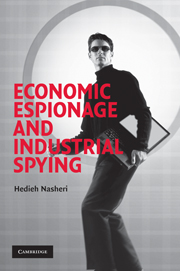Book contents
- Frontmatter
- Contents
- Preface
- Acronyms and Abbreviations
- 1 Dimensions of Economic Espionage and the Criminalization of Trade Secret Theft
- 2 Transition to an Information Society – Increasing Interconnections and Interdependence
- 3 International Dimensions of Business and Commerce
- 4 Competitiveness and Legal Collection Versus Espionage and Economic Crime
- 5 Tensions Between Security and Openness
- 6 The New Rule for Keeping Secrets – The Economic Espionage Act
- 7 Multinational Conspiracy or Natural Evolution of Market Economy
- Appendix A
- Appendix B
- Appendix C
- Notes
- References
- Index
5 - Tensions Between Security and Openness
Published online by Cambridge University Press: 05 June 2012
- Frontmatter
- Contents
- Preface
- Acronyms and Abbreviations
- 1 Dimensions of Economic Espionage and the Criminalization of Trade Secret Theft
- 2 Transition to an Information Society – Increasing Interconnections and Interdependence
- 3 International Dimensions of Business and Commerce
- 4 Competitiveness and Legal Collection Versus Espionage and Economic Crime
- 5 Tensions Between Security and Openness
- 6 The New Rule for Keeping Secrets – The Economic Espionage Act
- 7 Multinational Conspiracy or Natural Evolution of Market Economy
- Appendix A
- Appendix B
- Appendix C
- Notes
- References
- Index
Summary
the u.s. information and communications infrastructure sector generates more revenue than most nations produce. Far more than any other nation, the potential of new technologies has enabled the United States to reshape its governmental and commercial processes. All countries that make use of computer technology and especially those connected to the Internet are vulnerable, although the level to which the United States has incorporated new technologies and the highly networked nature of its infrastructure makes it the most vulnerable.
Some experts have questioned whether such an open and flexible global information infrastructure is still in the best interests of the United States and the world in light of the growing threats from information warfare, information terrorism, and cybercrime. One must keep in mind this state of the world in assessing the efficacy of any proposed international agreement that portends to address the serious and far-reaching effects of information warfare, information terrorism, and cybercrime.
Growing Vulnerability in the Information Age
President Clinton chose his commencement address to the 1998 graduating class of the U.S. Naval Academy as a forum for highlighting the escalating threat posed by information warfare, information terrorism, and cybercrime:
Our security is challenged increasingly by nontraditional threats from adversaries, both old and new, not only hostile regimes, but also international criminals and terrorists who cannot defeat us in traditional theaters of battle, but search instead for new ways to attack by exploiting new technologies and the world's increasing openness.
- Type
- Chapter
- Information
- Economic Espionage and Industrial Spying , pp. 95 - 123Publisher: Cambridge University PressPrint publication year: 2004



